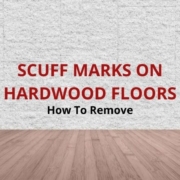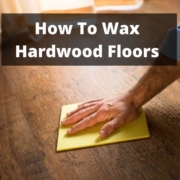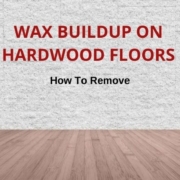How to Repair Water-Damaged Hardwood Floors
Hardwood floors are known for being durable and resilient, but they have one big weakness: water.
Wood flooring can stand up to years of heavy use, but a little water over time can ruin the beautiful hardwood.
Maybe you moved into a house with a damaged wood floor or maybe you have had a flood from the kitchen or bathroom plumbing. If you are noticing stained or warped wood or big gaps between boards, you have water damage.
There are some ways that you can repair water damage you find on your hardwood floors, but sometimes you will need to replace the flooring altogether.
This guide will help you identify the type of damage, find out how to repair water-damaged hardwood floors, and teach you how to prevent future water damage.
How Can I Tell If I Have Water Damage on My Hardwood Floor?
If you recently had a small flood or water leak, you probably know that your wood floor has some water damage.
But if you’re not sure, you can inspect the floor visually for some of the signs of water-damaged flooring.
Wood Floor Staining
Water stains on a wood floor take the shape of an uneven ring that ripples across the wood from the water source. The stains can be either light or dark. Stains with a white outline are easier to repair at home than darker stains, which indicate a complete soaking of the hardwood floor.
Wood Floor Cupping
Cupping is one of the ways that hardwood flooring can warp out of shape when wet. You can identify cupping on your hardwood floor when the edges of the individual boards bend upward and are no longer even with the center part of the boards. It gets its name from the cup or bowl shape each plank takes when the edges rise up. Cupping can also make the gaps between floorboards expand, leaving uncomfortable cracks.
If you want to learn what to do about cupping on your hardwood floor, check out our article on cupping in hardwood floors.

Wood Floor Crowning
Crowning occurs in a similar way to cupping, except the boards warp the opposite way. Crowning floorboards rise up in the middle, creating a bowed or bumpy appearance on each individual board. This is due to the floor pieces expanding and pressing into each other too much. Once the floor dries, it may leave large gaps between pieces.
Wood Floor Buckling

Buckling is the most extreme type of hardwood water damage. This is when the floor planks are pushed so tightly together that they actually detach from the subfloor. The extreme moisture in the wood causes each floorboard to expand. This can make a large hump in the floor or break the locking tongue-and-groove systems between boards.
Buckling is most likely if your hardwood flooring was installed poorly to begin with or in an extreme flood (such as gallons of water pouring in from a hurricane or a burst pipe).
If you suspect your water damage is so bad that the hardwood floor is buckling, check out our article specifically on buckling wood flooring.
Should You Fix or Replace Water-Damaged Wood Floors?
Once you have water damage on your wood floor, you might wonder if you can get away with fixing the floor instead of paying to replace it. This is especially tempting if your water damage is only a small area of the room.
It may not be safe to live with a water-damaged floor if it was wet enough for mold and other bacteria to grow.
In cases of severe floods or a leak of tainted water (like sewer water), you probably need to replace the whole floor to be safe. These molds or bacteria can be extremely dangerous to live with. Plus, severe leaks can weaken the subfloor and other structural pieces of your home.
If you are concerned that your wood floor may be growing mold, read our article about how to remove mold on a hardwood floor.
If your water damage came from clean water and you are able to dry the floor out completely, you can think about fixing the floor instead.
The problem with fixing hardwood floors is that it can be difficult to match the finish on a repaired section with the original finish.
If the water damage is in an out-of-the-way place or if you can throw a rug over it to hide the difference, repairing it may be a good option. Or, if the hardwood is only in one room of your house, you may be able to refinish the entire floor so it comes out an even color.
Your choice will depend on safety and whether you want to live with a repaired area that may look different than the rest of the floor.
You might consider replacing a section of the hardwood floor with a cheaper and more durable material, like ceramic tile. This is especially common in front of an entry door. You can remove the damaged section of hardwood and install tiles with a neat transition rather than having a section of hardwood that was obviously repaired.
Identifying the Source of the Water
If you find water damage on your hardwood floor that wasn’t there before, you need to be sure where the water came from. The source of the water makes a big difference in the decision of whether you should fix or replace your floors because some water sources may carry harmful bacteria.
What to Do When You Can’t Find The Leak
Sometimes the source of water damage is not obvious. You will want to fix problems before you fix the hardwood flooring so that you don’t have the same damage again on your newly repaired floor.
You can usually narrow water damage in a home down to two categories: external water sources and internal water sources.
External water sources dampen your home through the walls, roof, or foundation. Common external sources include:
- Overwhelming amounts of water from a storm or flood
- Overwatering a yard
- Doors and windows with leaky seals, or that are left open
- A leaking roof
- A cracked foundation or inadequate or broken drainage system (sump pump)
Internal water sources come from inside the house. Some common leaks include:
- Broken plumbing seals, such as radiator pipes or drains under a sink
- Leaking pipes inside a wall or floor (especially if the pipes have frozen)
- Failing hot water heaters
- Soft hoses such as the water supply on a refrigerator or dishwasher (these often get pinched when moving appliances and should be replaced every few years)
- Overflow from a sink or shower
- A spilled mop bucket or mopping with too much water
These examples can probably help you find the source of the leak so it can be repaired. If you still have no idea where your water damage is coming from or you suspect it is coming from inside your walls, you probably need to call a plumber.
Is The Water Fresh or Dirty?
The water that stained your floor should fit into one of the following three groups:
- Clean Water, such as rainwater from an open window, overflow from a sink or tub, or a leaking hot water heater. This water is mostly pure and will carry very few bacteria. Unless the area was wet for several days (enough for mold to grow), this kind of water damage is probably not dangerous.
- Used or “Gray” Water, such as that from a drainpipe under a sink or shower, has been exposed to some dirt and other waste. If this kind of damage doesn’t dry quickly, it will grow bacteria and mold.
- Dirty or “Black” Water is tainted water or sewage. This is from a leaking, overflowing, or backed-up septic line. This water is full of dangerous bacteria. You can try to sanitize the wood if it is only a minor leak (1 or 2 liters), but most of the time a black water leak will require replacing the floor. You should wear gloves and a filtering mask when you clean any area damaged by black water.
Identifying the source of the water damage will help you decide whether it’s safe to repair the floor. Of course, this is also the time to correct the problems that allowed water to get onto your floor such as by replacing window seals or calling a plumber to fix a pipe.
How to Fix Water-Damaged Wood Flooring
Depending on how much of the flooring was affected by water damage, you might need to call a professional to repair your water-damaged wood floors. They will be more experienced in sanding and staining the floor evenly. It can be a difficult process, but if you are confident in your DIY abilities, you should be able to pull it off.
After you get the floor completely dry and knock down the warped and water-damaged areas, the process is mostly the same as refinishing a worn-out floor. Feel free to read our other articles on that process, but we will include the steps here.
Step 1: Dry the Floor if it is Still Wet
If your water damage is new, you will need to dry the boards off before you can really assess the damage or make any repairs.
Standing water on the surface can be sucked up with a shop vacuum on wet mode. A squeegee can help push the water toward the vacuum hose.
Then the wood needs time to dry out internally. You can speed this process up by using fans and open windows to ventilate the room. You can also rent or buy a dehumidifier machine.
Be careful not to dry the floor too fast. Applying heat to a wet floor, for instance, can lead to more cupping or crowning. Hardwood needs to adjust gradually to temperature and humidity changes, so stick to natural airflow methods to dry the wood.
Step 2: Check for Extra Floorboards in Storage and Install Them
Usually, flooring installers will leave a few leftover pieces of wood at the house when they put in a floor. If the flooring in your house is decades old, you probably won’t have this luxury, but it doesn’t hurt to look.
A few pieces of flooring may be enough for a flooring installer to remove the damaged boards and replace them with new ones that will match perfectly. This is potentially the easiest way to repair your water-damaged floor, so look around.
Removing the old boards and laying new ones requires experience and the right tools. This is especially true if the wood floor is glued or nailed down. You most likely need a flooring expert to come to your house and replace the boards.
If the match on the finish is close after you install the new boards, this may be all you need to do. If the color difference is really bad, you will want to go on to the refinishing process.
Note that buffing and refinishing the floor will not only be more difficult, but more expensive. You will have to get the tools and supplies to refinish the floor.
Step 3: Sand the Floor
After you place new planks where the damaged ones were, or if you do not have any planks to weave into the floor, you are going to need to sand the flooring.
The right sander for the job is one that is specifically made for flooring. These have a large sanding wheel and a heavy head so that you can sand large areas quickly and evenly. You will probably need to rent it from a hardware store or flooring company.
Use a coarse grit sanding wheel first (around 60-80 grit) and follow with a fine sander (100-150 grit or a fine sanding screen).
You should sand the edges of the room by hand because it can be hard to maneuver the flooring sander into the edges and impossible to reach the corners. Use a fine sandpaper between 100 and 150 grit. Sand with the woodgrain.
If at all possible, you should sand the entire surface for the hardwood floor, or at least the entire room with water damage.
Move the sander across the entire surface of the floor, overlapping a few inches on each stroke. If you do not get the water-damaged sections flat on the first pass, you can try a second pass.
Do not sand the floor too many times unless you are sure that your planks are very thick. Taking too much thickness off the floor will cause problems.
Note: Wear a mask or respirator when using a flooring scuff sander. These machines will kick up a lot of dust as they sand the finish and wood.
Step 4: Clean the Sanded Hardwood Flooring
Use a vacuum to remove all of the sawdust you created by sanding the floor. Follow the vacuuming up with a dry microfiber cloth or dust mop. This will get the fine dust off of the floor.
This process will also remove other dirt and make the stain adhere better to the wood.
It’s good to do this not just after the sanding is complete, but every five minutes while you sand.
You can also vacuum the sander wheel to remove the dust. If it clogs up too much, it won’t sand evenly.
Step 5: Stain the Sanded Wood Floor
Following the directions on the can, apply the desired color of stain to the hardwood floor. Try to select a stain that is specifically made for hardwood floors.
Note that most wood stains will put off some strong fumes. You need to wear a respirator if possible, or at least ventilate the room by opening windows and using fans (not directly as they will dry out your stain too fast and blow dust around).
Start by applying a thin, even coat of stain to a small area (less than 1 square meter). Brush the edges and corners first to make sure you don’t miss them. Use a clean rag to wipe up all the excess wood stain.
You will have permanent lines in the finished coat if you let the leading edge of your stain dry. Try to work quickly and don’t leave any edge to dry for more than 10 or 15 minutes. Apply the stain evenly across the whole room.
Note: Make sure to have an exit strategy when you start staining. You don’t want to step across a wet stain to get out of a corner. Work from the deepest corners of the room toward the door.
Step 6: Apply Polyurethane
A coat of polyurethane on top of the stain will protect the floor from scuffs and create a water-resistant barrier.
You can roll polyurethane onto the floor like paint after the stain is completely dry.
The key to applying polyurethane is that you need a very thin, even coat to create a nice-looking finish. Choosing the right roller will help.
Don’t use a regular fuzzy paint roller or you will leave a coat that’s way too thick. Use a dense foam roller for a smooth finish. Also, use a long handle for the roller so you can see better while you work.
Cut in the edges of the room with a good quality paintbrush first and then use the roller to complete the center of the room.
Give the refinished floor a day to dry before moving furniture back into it and you will have a fully improved hardwood floor!
Preventing Water Damage to Your Hardwood Flooring
It’s always easier and cheaper to take care of problems before they become problems. Take care to avoid wood floor water damage in the first place.
Here are some ideas to prevent water damage to your hardwood flooring:
- Keep doors and windows closed when you are away from home and repair small leaks as soon as you notice them.
- Hire only licensed contractors to work on your plumbing.
- Be especially careful of rubber or plastic hoses on washing machines, dishwashers, and refrigerators tha.t can break over time.
- Invest in shower curtains, shoe mats, and other items to keep daily water off your floor.
- When you clean your floor, do not bring a big bucket of mop water where it can spill on your hardwood floor and mop only with a small amount of water.
- Clean up all spills immediately.
- Keep your house warm enough to avoid freezing temperatures that can burst a pipe.
Table of Contents







